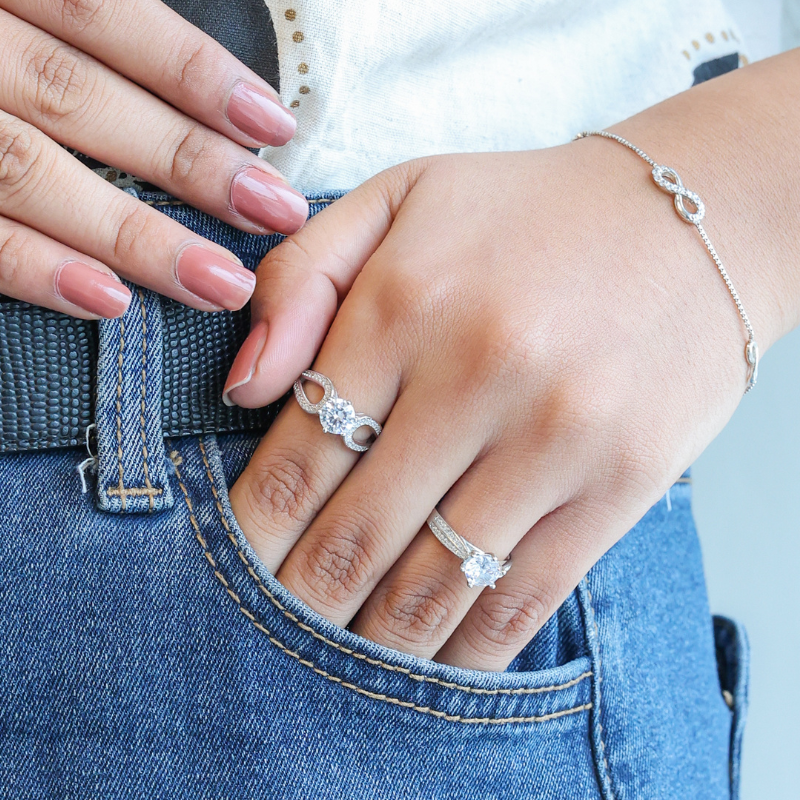In the shimmering world of fine jewelry, tableware, and fashion accessories, few materials possess the enduring appeal and versatility of silver. Yet, as you shop, two terms dominate the market, often used interchangeably, yet describing fundamentally different products: Sterling Silver and Silver Plated.
For the fashion-forward consumer, the quality-driven business owner, and the SEO-savvy researcher, understanding the profound differences between these two is not just about price—it's about metallurgy, durability, value, and ethical fashion business practices.
This in-depth comparison will illuminate the science, structure, and real-world implications of choosing between a solid silver alloy and a silver coating, ensuring you make a decision that aligns with your values and investment goals.
The Core Difference - Composition and Craftsmanship
The essential distinction between Sterling Silver and Silver Plated items lies in their very atomic structure. One is a foundational material; the other is a surface treatment.
1. Sterling Silver: The Standard of Quality
Sterling Silver is not pure silver. Pure silver (99.9% purity) is a beautiful metal, but it is too soft, malleable, and easily scratched for use in durable items like daily-wear jewelry or functional flatware. To solve this, metalsmiths created an alloy.
-
Composition: 92.5% Silver
-
Sterling Silver is defined by its millesimal fineness of 925. This means the metal contains 92.5% (or 925 parts per thousand) of pure silver (Ag).
-
The remaining 7.5% is composed of other metals, typically copper (Cu), though sometimes zinc or nickel may be used.
-
The Role of the Alloy: The addition of copper is the ingenious element. It provides the hardness, durability, and strength needed for the metal to withstand daily wear, yet it preserves the characteristic lustrous white sheen of silver.
-
Craftsmanship: Sterling silver items are solid pieces of this alloy. When a ring or a bracelet is stamped with "925," that entire piece—from surface to core—is composed of the same valuable material.
2. Silver Plated: The Surface Solution
Silver Plated refers to an item created from an inexpensive base metal that has been coated with a very thin layer of pure or sterling silver. It offers the look of silver without the intrinsic value of a solid silver alloy.
-
Composition: Base Metal Core
-
The vast majority of the item's mass is a base metal, such as brass, copper, nickel silver (an alloy of copper, nickel, and zinc), or sometimes stainless steel.
-
The outer layer is a micron-thin coating of silver, applied through an electrical process called electroplating.
-
The Plating Process (Electroplating): The base metal object is submerged in a chemical solution containing silver ions. An electric current is passed through the solution, causing the silver ions to bond to the surface of the base metal.
-
Thickness: The silver layer is incredibly thin, often ranging from 0.5 to 10 microns (a micron is one-millionth of a meter). For comparison, a human hair is around 50 to 100 microns thick.
-
Common Markings: Unlike Sterling Silver's standardized "925," plated items may have markings indicating the base metal, such as EPNS (Electroplated Nickel Silver) or just EP (Electroplate).
| Feature | Sterling Silver (925) | Silver Plated |
|---|---|---|
| Purity/Composition | 92.5% Pure Silver, 7.5% Alloy (mostly Copper) | Thin layer of silver over a base metal (Brass, Copper, Nickel) |
| Material Structure | Solid metal alloy throughout the entire piece. | Base metal core with a fragile surface coating. |
| Authenticity Mark | 925, .925, or Sterling | EP, EPNS, or no mark at all. |
Durability, Lifespan, and Everyday Wear
For the consumer, the most significant real-world difference is how the material holds up over time.
3. Durability and Wear
| Factor | Sterling Silver | Silver Plated |
|---|---|---|
| Scratch Resistance | Highly durable. Deep scratches reveal the same silver alloy underneath and can be buffed out. | Very low durability. Scratches easily remove the thin silver layer, exposing the dull, different-colored base metal. |
| Chipping/Flaking | None. It is a solid material. | High risk. The thin electroplated layer can flake or peel away with heavy use, especially on edges or high-contact areas like rings. |
| Daily Use | Designed for daily, continuous wear. It is strong enough for heirloom-quality jewelry and flatware. | Suitable for occasional, fashion-focused wear. Constant exposure to friction will quickly wear through the plating. |
4. Tarnish, Patina, and Cleaning
Both Sterling Silver and Silver Plated items will tarnish, but they do so for different reasons, and the cleaning process is drastically different.
-
Tarnish in Sterling Silver: Tarnish (a dark, dull discoloration) is caused by the sulfur compounds in the air reacting with the copper element in the alloy to form silver sulfide (Ag2S).
-
The Fix: Because the piece is solid silver, it can be polished aggressively—repeatedly and over decades—with professional silver polish or polishing cloths, removing the tarnish and revealing the bright silver underneath without ever damaging the material.
-
Tarnish in Silver Plated: Plated items also tarnish, but they are also prone to corrosion from the exposed base metal. The moment the thin silver layer is breached, the underlying base metal (often copper or brass) begins to react with oxygen and moisture.
-
The Problem: Once the base metal is exposed, the item is effectively ruined. You cannot use standard silver polish on plated items because the friction will quickly wear away the remaining thin silver layer. Cleaning must be exceptionally gentle.
Investment, Value, and Fashion Business Sense
Beyond aesthetics and wearability, the choice between the two materials has profound financial and business implications.
5. Price and Intrinsic Value
-
Sterling Silver: Carries a higher initial price tag because its value is tied directly to the spot price of silver and the cost of skilled craftsmanship. It is an intrinsic investment—you are buying a measurable quantity of a precious metal. It has a melt value that fluctuates with the global silver market.
-
Silver Plated: Is significantly cheaper because its value is purely aesthetic, not intrinsic. The cost is driven by the base metal (which is inexpensive) and the negligible amount of silver used for the coating. It has no significant resale or scrap value based on silver content.
6. Hypoallergenic Properties and Skin Reaction
This is a major factor for consumers with sensitive skin.
-
Sterling Silver (Generally Hypoallergenic): The high percentage of silver and the typical use of copper (a safe alloy) make it an excellent choice for sensitive skin. It rarely causes a reaction. The darkening of the metal is a tarnish, not a skin irritation.
-
Silver Plated (Potential Allergen): The base metal is the main risk. If the base contains a high amount of nickel—a common allergen—the plating will eventually wear through, and the nickel will come into contact with the skin. This can lead to a rash, irritation, and the notorious "green skin" phenomenon.
7. Sustainability and Ethical Sourcing
For a modern, conscious fashion brand, the business model surrounding the material is key.
-
Sterling Silver: Offers strong avenues for sustainability. The material is 100% recyclable without loss of quality. A piece of sterling silver can be melted down and reformed indefinitely. Brands can emphasize using recycled sterling silver to appeal to eco-conscious consumers.
-
Silver Plated: Poses a significant sustainability challenge. The core is an alloy of various non-precious metals that are difficult and expensive to separate from the minute silver coating. It is more likely to end up in a landfill when the silver wears off, as it is often not economically viable to recycle.
Conclusion: Matching the Material to the Purpose
The informed choice between Sterling Silver and Silver Plated items hinges on the piece's intended purpose, the buyer's budget, and the desired lifespan.
| Purpose | Recommendation | Rationale |
|---|---|---|
| Everyday Jewelry/Rings/Chains | STERLING SILVER | Durability, resistance to wear from constant friction, and hypoallergenic properties. |
| Heirloom Gifts/Investment Pieces | STERLING SILVER | Retains intrinsic value, can be polished endlessly, and lasts for generations. |
| Fashion Trends/Seasonal Accessories | SILVER PLATED | Offers a beautiful look at an affordable price point for pieces that are not meant to last forever. |
| Costumes/Occasional Wear | SILVER PLATED | The lower cost is ideal for one-off events or non-sentimental items. |
For a brand built on quality, longevity, and timeless style, Sterling Silver is the undisputed choice. It represents a promise of enduring value and responsible material usage. Silver Plated serves a different, more transient, fashion market. By understanding the core differences outlined in this definitive guide, you empower yourself to shop with confidence and invest wisely in pieces that will truly stand the test of time.









